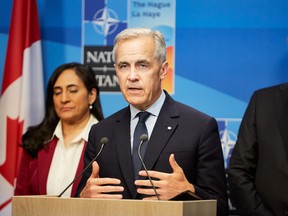
Article content
Prime Minister Mark Carney says Canada will spend five per cent of its nominal gross domestic product on defence by 2035, which economists say is a commitment that will have significant fiscal implications, including higher deficits.
THIS CONTENT IS RESERVED FOR SUBSCRIBERS ONLY
Subscribe now to read the latest news in your city and across Canada.
- Exclusive articles from Barbara Shecter, Joe O'Connor, Gabriel Friedman, and others.
- Daily content from Financial Times, the world's leading global business publication.
- Unlimited online access to read articles from Financial Post, National Post and 15 news sites across Canada with one account.
- National Post ePaper, an electronic replica of the print edition to view on any device, share and comment on.
- Daily puzzles, including the New York Times Crossword.
SUBSCRIBE TO UNLOCK MORE ARTICLES
Subscribe now to read the latest news in your city and across Canada.
- Exclusive articles from Barbara Shecter, Joe O'Connor, Gabriel Friedman and others.
- Daily content from Financial Times, the world's leading global business publication.
- Unlimited online access to read articles from Financial Post, National Post and 15 news sites across Canada with one account.
- National Post ePaper, an electronic replica of the print edition to view on any device, share and comment on.
- Daily puzzles, including the New York Times Crossword.
REGISTER / SIGN IN TO UNLOCK MORE ARTICLES
Create an account or sign in to continue with your reading experience.
- Access articles from across Canada with one account.
- Share your thoughts and join the conversation in the comments.
- Enjoy additional articles per month.
- Get email updates from your favourite authors.
THIS ARTICLE IS FREE TO READ REGISTER TO UNLOCK.
Create an account or sign in to continue with your reading experience.
- Access articles from across Canada with one account
- Share your thoughts and join the conversation in the comments
- Enjoy additional articles per month
- Get email updates from your favourite authors
Sign In or Create an Account
or
Article content
“You’re looking at deficits in the order of $70 billion to $75 billion annually over the next couple of years and then by 2035 reaching around $90 billion by the end of the forecast,” Randall Bartlett, deputy chief economist at Desjardins Group, said.
Article content
Article content
Article content
The new target, which was pushed by United States President Donald Trump on all North Atlantic Treaty Organization (NATO) members, is split into two spending categories, with 3.5 per cent going to core defence spending and 1.5 per cent going to defence-adjacent spending, such as infrastructure.
Article content
By signing up you consent to receive the above newsletter from Postmedia Network Inc.
Article content
In an interview with CNN on Tuesday, Carney said Canada will have to annually spend $150 billion to achieve the five per cent target and that it would include significant investments in critical minerals.
Article content
In a press conference on the sidelines of the NATO summit in The Hague, Netherlands, on Wednesday, he said the trajectory and balance of spending under this plan will be reviewed in 2029.
Article content
Bartlett said the expected annual spending from this new commitment will be much more than the figure quoted by Carney.
Article content
“That number is pretty much the lowest number you could put out there if you’re hitting 3.5 per cent of GDP by 2035,” he said. “In reality, it’s probably going to be larger than that, and if you take it up to five per cent, then you’re beyond $200 billion in defence and defence-adjacent spending.”
Article content
Article content
Bartlett said he is operating with very little information from the federal government, which has not provided details on how it plans to pay for these expenditures.
Article content
Article content
The federal government is expected to table a budget in the fall. Carney has promised to split operational and capital spending into two separate budgets, with a promise to balance the operational budget within three years.
Article content
The Liberal Party election platform in April promised $130 billion in net new spending over four years and projected a deficit of $62.3 billion for the fiscal year 2025-2026.
Article content
But many of the platform’s projections were based on a rosier picture of the economy. Since then, the federal government has committed to more spending, including that Canada would meet its 2014 NATO defence spending target of two per cent of GDP this fiscal year.
Article content
Under that announcement, Carney said he would expand the security mandate of the Canadian Coast Guard (CCG) and begin the process of moving the agency under the Department of National Defence from Fisheries and Oceans Canada.
Article content
“The plan is to spend a lot of money on defence and infrastructure, including critical minerals,” Derek Holt, an economist with the Bank of Nova Scotia, said in a note. “Other than missing parts, like how it gets implemented and what the money will be spent on, the part that’s missing is who pays for it.”

.jpg) 6 hours ago
1
6 hours ago
1
 English (US)
English (US)